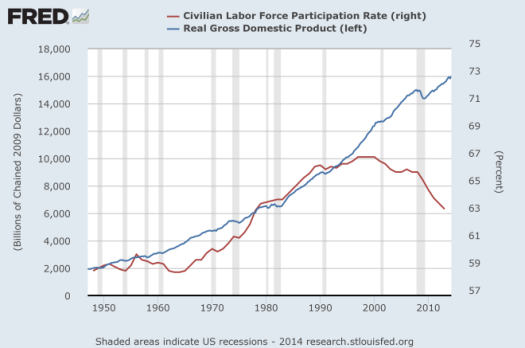The Labor Force Participation Rate (LFPR) is calculated monthly by the Bureau of Labor Statistics (BLS). It’s defined by the BLS as “the labor force as a percent of the civilian noninstitutional population.”
This seems straightforward enough, but I’ve seen many analysts misinterpret what the LFPR actually measures–especially as it’s been in a sort of free fall for the past several years–and therefore misapply it when gauging the health of the labor force.
Here’s the key: For the BLS, the “labor force” includes everyone who is either employed or unemployed-but-seeking-employment. This means that LFPR, labor force participation rate, does not fall when more people become unemployed. It falls when people drop out of the labor force entirely.
In other words, LFPR changes only when the percentage of people not seeking work changes relative to the total number of working-age people.
Of course, some of those people dropping out of the labor force are what the BLS calls “discouraged workers“–people who are not looking for a job, but want and are available for work. In this case, a falling LFPR can indicate hard times. But recent research shows that such workers are not the biggest reason for the LFPR’s decline. Shigeru Fujita at the Federal Reserve Bank of Philadelphia shows that an accelerating rate of retirement, coinciding with the aging of America’s workforce, is behind much of the decline (which, for that matter, began in 2000–long before the 2008 recession). Of those who dropped out of the labor force for reasons other than either retirement or becoming disabled, those in school comprise the fastest subset of working-age people not seeking work.
So LFPR should never be used as a standalone measure of the health of the labor force. Nor can it’s decline serve as a “check” on the falling unemployment rate without analyzing the causes of that decline. Indeed, the LFPR fell almost every year from 1956 to 1964, during which time GDP grew by roughly 50 percent. Same story between 1998 and 2008.
To conclude, I’ll pose an interesting question: Should we expect LFPR to rise or fall as the population becomes wealthier in general? Will more or less people be working in, say, the year 2100, when (I hope) we’ll be more productive than we are today? (Hint: The answer has to do with the labor-leisure trade-off.)

